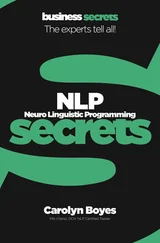It utilizes specific language patterns
Utilization of language patterns provides powerful techniques for interacting with others and bringing about change. NLP has a wide range of language processes and patterns that can be applied in a variety of contexts.
It works with both the conscious and the unconscious mind
The terms ‘conscious’ and ‘unconscious’ have been used in various parts of this book. The state of consciousness is generally recognizable as an awareness of oneself or elements in one’s environment (or beyond).
The term ‘unconscious’ is commonly applied to states such as sleep, anaesthesia or fainting, but can also be used to describe mental processes that are ‘out of awareness’. These ‘out-of-awareness’ processes can include a wide range of things; for example having a mannerism of which one is not consciously aware, becoming familiar with a language simply by being exposed to hearing it rather than consciously taking time to learn the words or grammar, or responding to something in an automatic way without being aware of why that is happening (for example considering a person attractive because the pupils of their eyes are dilated, but not being aware that that fact is influencing your reaction).
Although there are differing views on how, or whether, unconscious processes actually exist (they could simply be pre-programmed behaviour rather than evidence of an ‘unconscious’ part of the mind), there is a general acceptance that the unconscious mind does exist and has a powerful influence on our attitudes and behaviour. This influence may be either positive or negative, resulting in behaviour which either achieves beneficial results or hinders them. The recognition of the influence of the unconscious mind informs much of NLP’s work, so that, although it is possible to use NLP to work solely at a conscious level, for example to break down a skill into concrete parts in order to teach it, it is probably most effective when it integrates conscious/unconscious processing. For example, when teaching a skill to people who believe that they will find it hard to learn, it is possible to manage the process of teaching so that it incorporates elements which reach the unconscious mind and are directly absorbed by the learner at a deep level.
A note of caution should be added here. Because some techniques appear to work directly at an unconscious level, bypassing conscious awareness, they could be open to misuse or could inadvertently cause undesirable results. Such techniques should therefore only be used after sufficient training and with the safeguards of respect and concern for the person who is ‘on the receiving end’. For this reason, certain techniques have only been described in outline in this book, so that they will not be practised without sufficient guidance and skill.
It is rapid in its processes and results
A major feature of NLP is the speed with which it can produce results. Many NLP techniques are extremely rapid in their application (the most famous probably being the ‘fast phobia cure’, which can successfully be carried out in a matter of minutes). Because of the speed of such processes, many people do not believe they can really work and are therefore sceptical about NLP as a whole. Current thinking, however, is that the brain works (and learns) speedily and therefore change can be brought about rapidly. This is in contradiction to many traditional approaches, especially that of psychoanalysis, which maintain that lengthy courses of treatment – often running into years – and taking people back into the past, instead of having the future focus that is characteristic of NLP, are necessary to bring about insight and change.
It is neutral as an approach
NLP as an approach is neutral. It is a tool, not a prescription. How NLP is used depends entirely on the practitioner and the user/client. There are as many ways of using NLP as there are people working with it.
It is respectful in how it treats people
An interesting thing about NLP is that one of its principles involves respect for others; its importance is instilled from the early stages in training. Because of this, attention is paid to what is termed ‘ecology’, which in NLP means the circumstances surrounding any particular intervention. To be ecological means considering the broader context of an intervention, paying attention to the needs and wishes of the person/s with whom you are working, taking into account their point of view as well as your own beliefs about what is desirable. This emphasis on ethics makes NLP stand out from many other disciplines.
Another feature of NLP is its ‘presuppositions’. These are statements which are not necessarily held to be ‘true’, but used as assumptions which influence strongly the behaviour and responses of those using NLP. Here are some of NLP’s commonest presuppositions:
There are patterns to how we think about/organize our experience, and if we change these patterns, our experience changes with it.
A map is not the territory
People’s perceptions are subjective; what you perceive is selective, not a complete, or necessarily true, account of reality. So, for example, a colour-blind person would not perceive certain distinctions in colour, but this does not mean they do not exist. Similarly, a person might construe another’s behaviour as malevolent, but this might not be the case. We see and respond according to our own selectively filtered ‘maps of the world’ and helping people understand theirs, and acknowledge those of others, is a feature of NLP.
The mind and body are one system
What we do with our minds and our bodies is interlinked. For example, sitting in a particular posture can lead us to feel a particular emotion; similarly, a positive thought will have an effect on our physiology. There is currently much emphasis on the interrelation of mind and body on health (for example the use of visualization in helping fight cancer) and the field of PNI (psychoneuroimmunology) is demonstrating such links on an ongoing basis.
Instead of thinking of people as faulty because they do not do what seems to be appropriate, conventional or effective, it is useful to think of them as being extremely effective at getting particular results, even though these results may not be the ‘best’ in the circumstances. So, for example, someone who has a phobia, say of spiders, is excellent at maintaining a frightened response; this may be inappropriate for house spiders, but could be a real help in keeping away from poisonous spiders in a tropical country.
If something is possible for one person it is possible for everybody
This does not mean that everyone can be an Olympic athlete, brain surgeon or artist; it simply means that if something can be done by one person, then potentially everyone could do it, given suitable resources. This presupposition is helpful in encouraging people to extend their performance beyond what they might previously have believed possible.
Everyone has all the resources they need
People have within themselves a vast reservoir of ‘internal’ abilities and attributes; achievement is generally more about what you bring to a situation than external elements.
There is no failure, only feedback
If you do not achieve what you set out to, this can be taken as useful information to help you in your future endeavours, rather than as evidence that you are incapable of achieving what you desire.
Читать дальше












